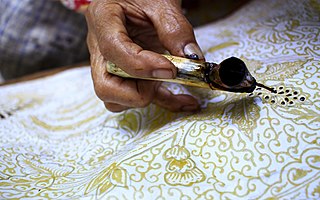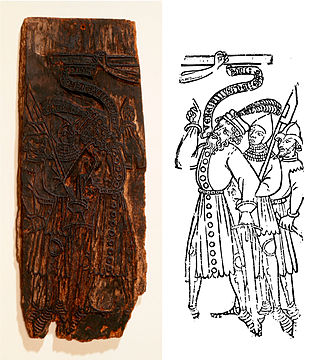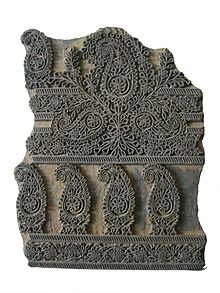
Calico is a heavy plain-woven textile made from unbleached, and often not fully processed, cotton. It may also contain unseparated husk parts. The fabric is far coarser than muslin, but less coarse and thick than canvas or denim. However, it is still very cheap owing to its unfinished and undyed appearance.

Printmaking is the process of creating artworks by printing, normally on paper, but also on fabric, wood, metal, and other surfaces. "Traditional printmaking" normally covers only the process of creating prints using a hand processed technique, rather than a photographic reproduction of a visual artwork which would be printed using an electronic machine ; however, there is some cross-over between traditional and digital printmaking, including risograph.

Woodcut is a relief printing technique in printmaking. An artist carves an image into the surface of a block of wood—typically with gouges—leaving the printing parts level with the surface while removing the non-printing parts. Areas that the artist cuts away carry no ink, while characters or images at surface level carry the ink to produce the print. The block is cut along the wood grain. The surface is covered with ink by rolling over the surface with an ink-covered roller (brayer), leaving ink upon the flat surface but not in the non-printing areas.

Batik is an Indonesian technique of wax-resist dyeing applied to the whole cloth. This technique originated from the island of Java, Indonesia. Batik is made either by drawing dots and lines of wax with a spouted tool called a canting, or by printing the wax with a copper stamp called a cap. The applied wax resists dyes and therefore allows the artisan to colour selectively by soaking the cloth in one colour, removing the wax with boiling water, and repeating if multiple colours are desired.

Woodblock printing or block printing is a technique for printing text, images or patterns used widely throughout East Asia and originating in China in antiquity as a method of printing on textiles and later paper. Each page or image is created by carving a wooden block to leave only some areas and lines at the original level; it is these that are inked and show in the print, in a relief printing process. Carving the blocks is skilled and laborious work, but a large number of impressions can then be printed.

Textile printing is the process of applying color to fabric in definite patterns or designs. In properly printed fabrics the colour is bonded with the fibre, so as to resist washing and friction. Textile printing is related to dyeing but in dyeing properly the whole fabric is uniformly covered with one colour, whereas in printing one or more colours are applied to it in certain parts only, and in sharply defined patterns.
The manufacture of textiles is one of the oldest of human technologies. To make textiles, the first requirement is a source of fiber from which a yarn can be made, primarily by spinning. The yarn is processed by knitting or weaving, which turns yarn into cloth. The machine used for weaving is the loom. For decoration, the process of colouring yarn or the finished material is dyeing. For more information of the various steps, see textile manufacturing.

Printing in East Asia originated in China, evolving from ink rubbings made on paper or cloth from texts on stone tablets, used during the sixth century. A type of printing called mechanical woodblock printing on paper started in China during the 7th century in the Tang dynasty. The use of woodblock printing spread throughout East Asia. As recorded in 1088 by Shen Kuo in his Dream Pool Essays, the Chinese artisan Bi Sheng invented an early form of movable type using clay and wood pieces arranged and organized for written Chinese characters. The use of metal movable type was known in Korea by the 13th century during the Goryeo period, with the world's oldest surviving printed book using moveable metal type being from 1377 in Korea.

Ajrak, also known as Ajrakh, is a unique form of textile block-printing found primarily in Sindh, Pakistan and the village of Ajrakhpur in the bordering Kutch district of India. Ajrak textiles like shawls or dresses display special designs and patterns made using block printing with stamps. Ajrak is a symbol of Sindhi culture and traditions. Ajrak prints are also famous in neighbouring areas of India, in Gujarat, due to their influence from the Indus Valley civilization. Apart from Sindh and Kutch, recently, a Saraiki version of the Ajrak called Sajarak was created and is found in South Punjab, Pakistan.

Resist dyeing (resist-dyeing) is a traditional method of dyeing textiles with patterns. Methods are used to "resist" or prevent the dye from reaching all the cloth, thereby creating a pattern and ground. The most common forms use wax, some type of paste made from starch or mud, or a mechanical resist that manipulates the cloth such as tying or stitching. Another form of resist involves using a dye containing a chemical agent that will repel another type of dye printed over the top. The best-known varieties today include tie-dye, batik, and ikat.

The history of printing starts as early as 3000 BCE, when the proto-Elamite and Sumerian civilizations used cylinder seals to certify documents written in clay tablets. Other early forms include block seals, hammered coinage, pottery imprints, and cloth printing. Initially a method of printing patterns on cloth such as silk, woodblock printing for texts on paper originated in China by the 7th century during the Tang dynasty, leading to the spread of book production and woodblock printing in other parts of Asia such as Korea and Japan. The Chinese Buddhist Diamond Sutra, printed by woodblock on 11 May 868, is the earliest known printed book with a precise publishing date. Movable type was invented by Chinese artisan Bi Sheng in the 11th century during the Song dynasty, but it received limited use compared to woodblock printing. Nevertheless, the technology spread outside China, as the oldest printed book using metal movable type was the Jikji, printed in Korea in 1377 during the Goryeo era.

Roller printing, also called cylinder printing or machine printing, on fabrics is a textile printing process patented by Thomas Bell of Scotland in 1783 in an attempt to reduce the cost of the earlier copperplate printing. This method was used in Lancashire fabric mills to produce cotton dress fabrics from the 1790s, most often reproducing small monochrome patterns characterized by striped motifs and tiny dotted patterns called "machine grounds".

George Baxter (1804–1867) was an English artist and printer based in London. He is credited with the invention of commercially viable colour printing.
Turkey red is a dyeing methods that was widely used to give cotton a distinctive bright red colour in the 18th and 19th centuries. It was made using the root of the rubia (madder) plant, through a long and laborious process which originated in the historical Levant region, namely being developed in India and China. Turkey red was brought to Europe in the 1740s and in France was known as rouge d'Andrinople.

Natural dyes are dyes or colorants derived from plants, invertebrates, or minerals. The majority of natural dyes are vegetable dyes from plant sources—roots, berries, bark, leaves, and wood—and other biological sources such as fungi.
Chhapa, Chhapola or Khosla are the surname in Khatri caste which is belongs to Sikh and Hindu Kshatriya clan.

The woodblock fragment Bois Protat is a fragmentary woodblock for printing, and the images on it are the oldest surviving woodcut images from the Western world. It is cut on both sides, with a scene from Christ's crucifixion on the recto, and a kneeling angel from a presumed Annunciation scene on the verso. The crucifixion scene likely consisted of three or more blocks; the surviving block fragment features Longinus the Roman centurion at the Crucifixion, shown speaking with a banderole, a mediaeval precursor to the modern speech balloon containing his words.

African wax prints, Dutch wax prints or Ankara, are omnipresent and common materials for clothing in West Africa and Central Africa. They were introduced to West and Central Africans by Dutch merchants during the 19th century, who took inspiration from native Indonesian designs. They began to adapt their designs and colours to suit the tastes of the African market. They are industrially produced colourful cotton cloths with batik-inspired printing. One feature of these materials is the lack of difference in the colour intensity of the front and back sides. The wax fabric can be sorted into categories of quality due to the processes of manufacturing. The term "Ankara" originates from the Hausa name for Accra, the capital of what is now Ghana. Initially used by Nigerian Hausa tradesmen, it was meant to refer to "Accra," which served as a hub for African prints in the 19th century.

The perrotine is a block-printing machine invented by Louis-Jérôme Perrot, and practically speaking is the only successful mechanical device ever introduced for this purpose. For some reason or other it has rarely been used in England, but its value was almost immediately recognized on the Continent, and although block printing of all sorts has been replaced to such an enormous extent by roller printing, the perrotine is still largely employed in French, German, and Italian works.

William Morris (1834-1898), a founder of the British Arts and Crafts movement, sought to restore the prestige and methods of hand-made crafts, including textiles, in opposition to the 19th century tendency toward factory-produced textiles. With this goal in mind, he created his own workshop and designed dozens of patterns for hand-produced woven and printed cloth, upholstery, and other textiles.























